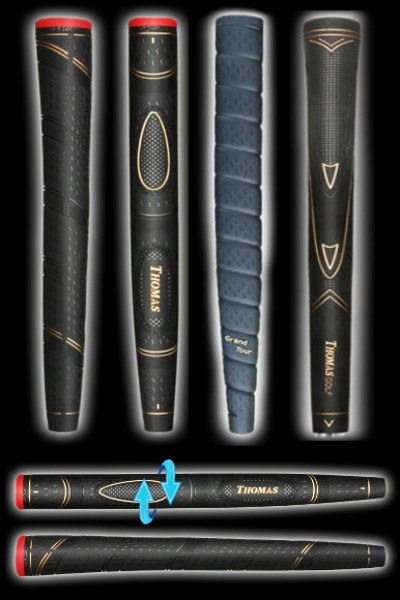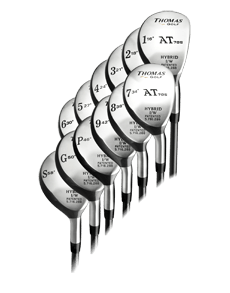|
Pros and Cons of Every Golf Grip Style |
Best Grip? Overlapping vs Interlocking |
Golf grips are a piece of equipment that often gets overlooked. Most players are willing to spend plenty of time and money finding the right club heads for their swing, and the right shaft to go in those club heads.
- However, when it comes time to pick out a grip, very little effort is put into the process. Since the grip is the only part of the club that you actually touch during the swing, it would be wise to take a little extra time to be sure you are picking out the right grips for your game.
- There are an incredible number of golf grips on the market today. They range from basic, low-cost models all the way up to advanced grips with plenty of features and a high price tag. You don’t necessarily need to break the bank in order to purchase a quality set of golf grips, but you probably don’t want to buy the cheapest ones you can find, either.
- Buying good grips that feel comfortable in your hand can have a dramatic effect on your ability to swing the club properly. Bad grips will only make the game harder – and golf is not a game that needs to be made any harder.Three Basic Points Regarding Golf Club GripsBefore getting into the specifics of different grip manufacturers and how to pick the right grips for you, there are a few points that need to be made. Grips aren’t nearly as complicated as shafts or club heads, but you still want to be sure that are doing everything you can to allow your grips to help you play better golf.
The following three points are important for any golfer to remember –
- Replace your grips before they wear out. Too many golfers continue to play with grips that are hard and slick – which is only going to make it more difficult to hit quality golf shots. Your grips should feel slightly tacky in your hands, and they shouldn’t be hard or cracked on the surface. As soon as you notice that your grips are slippery – even after you have cleaned them – it is time to put new grips on your clubs. Typically, you want to replace all of your grips at the same time to maintain consistency throughout your bag. Even if some of the lesser-used clubs (like long irons) aren’t worn out quite yet, it is smart to simply replace the whole set all at once and start over.
- Get fitted for your grips. Custom fitting of golf clubs is important when it comes to shaft flex and loft and lie angle, but it is also important when choosing grips. There are multiple grip sizes available, and you can also alter the thickness of the grip during the installation process. You can have a club fitting professional work with you to determine what size grips will work best. Using a grip that is too small can cause overactive hands in the golf swing, while a grip that is too large can make it difficult to release the club through the shot. It should be easy to tell when you find a grip that is ‘just right’ because the club will feel comfortable in your hands from the moment you pick it up.
- Wash your grips frequently. As you go through a round of golf, sweat and oils from your hands will be transferred into your grips. If you fail to wash your grips, they will quickly become slippery and hard to hold on to during your swing. To prevent having to replace your grips prematurely, get into the habit of washing the grips with a towel and some soapy water following every round. You don’t want to use a lot of water – just dip the towel in your bucket of soapy water and rub down each grip. Leave them out of your bag to dry and they should be ready to go for your next round.
Grip maintenance is important because you need tacky grips in order to maintain a light grip pressure on the club throughout your swing. When you play with slick grips, you will have to squeeze the club tightly in order to hold on to the club – and a tight grip is never a good thing in golf. Prior to each round, make sure that your grips are clean and in good condition. This seemingly minor step can go a long way toward helping you play your best.
Golf grips play a vital role in a golfer's performance and can significantly affect their control, comfort, and consistency. Here's what you need to know about golf grips:
- Importance of Golf Grips: The golf grip is the only connection between the golfer and the club. It influences how the clubface squares at impact, affects swing mechanics, and ultimately determines the accuracy and feel of the shot. Worn-out or ill-fitting grips can lead to loss of control, decreased performance, and discomfort.
- Types of Golf Grips: There are several types of golf grips available, including:
- Overlapping Grip: The most common grip used by golfers, also known as the Vardon grip. The little finger of the trailing hand overlaps the index and middle fingers of the lead hand.
- Interlocking Grip: Similar to the overlapping grip, but the little finger of the trailing hand is interlocked with the index finger of the lead hand. Often preferred by golfers with smaller hands or weaker grip strength.
- Ten-Finger Grip: Also known as the baseball grip, all ten fingers of the hands are in contact with the club. It provides more stability and control, making it suitable for beginners or golfers with weak grip strength.
- Grip Size: Golf grips come in various sizes to accommodate different hand sizes and grip preferences. Grip size can influence grip pressure, comfort, and shot direction. The most common grip sizes are undersize, standard, midsize, and oversized. Getting the right grip size is crucial for proper hand placement and control.
- Grip Materials: Golf grips are typically made from rubber, synthetic compounds, or leather. Rubber grips are the most popular due to their durability, affordability, and availability in different textures and firmness levels. Synthetic grips offer similar characteristics to rubber grips but may have enhanced moisture-wicking properties. Leather grips, less common today, provide a traditional feel but require more maintenance.
- Grip Texture: Golf grips can have different textures, ranging from smooth to highly textured or corded. Texture affects traction and feel. Grips with more texture provide enhanced grip security in wet conditions or for golfers with sweaty hands. Golfers often choose a texture that suits their preference and playing conditions.
- Regripping: Over time, golf grips wear out and lose their effectiveness. It is recommended to regrip clubs regularly, typically every 40-60 rounds or at least once a year. Regripping involves removing the old grip and replacing it with a new one. Many golf shops offer regripping services, or you can choose to do it yourself with the proper tools.
- Personal Preference: Ultimately, the choice of golf grip depends on personal preference and comfort. Golfers should experiment with different grips to find the one that feels best and provides optimal control and confidence. Working with a golf professional or club fitter can provide valuable guidance in determining the right grip for your game.
For seniors with stiff fingers, it's important to select golf grips that provide comfort, ease of use, and a secure grip. Here are a few types of golf grips that may be suitable:
- Oversized Grips: Oversized grips have a larger diameter than standard grips, providing a more substantial and cushioned feel. These grips can help seniors with stiff fingers by reducing grip pressure and allowing for a more relaxed grip. The extra size can also promote stability and reduce the tendency to squeeze the club tightly.
- Arthritic Grips: Arthritic grips are specifically designed for golfers with arthritis or joint pain. These grips have a softer and more shock-absorbing construction, which can help alleviate discomfort and make it easier to hold the club. They often feature a non-slip texture or contours that provide extra grip security.
- Ribbed Grips: Ribbed grips have a series of small ridges along the underside of the grip, promoting proper hand placement and preventing slippage. The ridges can help seniors with stiff fingers maintain a consistent grip position, enhancing control and reducing the need for excessive hand manipulation during the swing.
- Tapered Grips: Tapered grips have a larger diameter near the top of the grip and gradually decrease in size towards the bottom. This design can assist seniors with stiff fingers by providing a more comfortable grip and allowing for easier hand closure around the club.
- Winn Grips: Winn grips are known for their soft and tacky feel. They are made from advanced polymer materials that provide excellent cushioning and grip even in damp conditions. Winn grips can be beneficial for seniors with stiff fingers, as they offer a comfortable and secure hold on the club.
Remember, the golf grip is an essential aspect of your golf equipment, and maintaining proper grip condition and fit is crucial for consistent and effective performance on the course.






